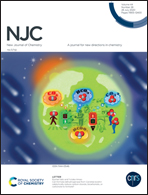Polyimide foams with outstanding flame resistance and mechanical properties by the incorporation of noncovalent bond modified graphene oxide†
Abstract
Graphene oxide (GO) plays an important role in improving the mechanical properties and flame resistance of materials. In this work, polyimide (PI) composite foams were in situ generated by introducing modified GO based on a novel method. GO was modified by the interaction of its surfactant groups with dopamine (Do) using noncovalent bonds, to facilitate its dispersion in the PI matrix. The π–π conjugation was confirmed between GO and Do. Chemical interactions occurred between GO and PI through the reaction between the active groups on GO and –NCO of isocyanates. The resulting PI composite foams were characterized for their morphological, structural, mechanical, thermal and flame retardant properties. The cell structure of PI composite foams was uniform. Meanwhile, the compressive strength of composite foams significantly increased from 130 kPa to 163 kPa, resulting in a distinct enhancement in mechanical properties. The thermal stability of the composite foams was highly enhanced by GO as evidenced by the decreased mass loss during the maximum decomposition stage and increased residue at 800 °C. Furthermore, the values of limited oxygen index (LOI) of PI foams increased from 42.0% to 44.5%, while the PI composite foams exhibited self-extinguishing property. Therefore the modified GO dramatically improved the mechanical, thermal and flame resistance properties of PI foams.



 Please wait while we load your content...
Please wait while we load your content...